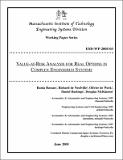| dc.contributor.author | Hassan, Rania | |
| dc.contributor.author | de Neufville, Richard | |
| dc.contributor.author | de Weck, Olivier L. | |
| dc.contributor.author | Hastings, Daniel E. | |
| dc.contributor.author | McKinnon, Douglas | |
| dc.date.accessioned | 2016-06-01T16:20:51Z | |
| dc.date.available | 2016-06-01T16:20:51Z | |
| dc.date.issued | 2005-06 | |
| dc.identifier.uri | http://hdl.handle.net/1721.1/102770 | |
| dc.description.abstract | This paper presents a simple but powerful Real Options Valuation methodology suitable for valuing flexibility in complex engineered systems. It is based on value-at-risk analysis and relies on a standard discounted cash flow approach. A case study on the architecting of flexible satellite fleets is presented. The architecting framework integrates spacecraft engineering design with economic analysis for the purpose of maximizing the financial value of a fleet to the operator under uncertain, evolving market conditions. The investigation considers the forecasted demand evolution for a satellite service in two distant geographical markets simultaneously and provides flexible fleet architectures that significantly improve various aspects of the value-at-risk distributions compared to those of a traditional, rigid fleet architecture. It is shown that the flexible architectures are able to capture more revenue, mitigate more risk and/or reduce overall required investment. The suggested Real Options “in” the system, rather than “on” the system, approach allows engineers, strategists, or decision makers in engineering establishments to embed flexibility in the design of complex systems for the purpose of maximizing their total lifetime value. | en_US |
| dc.language.iso | en_US | en_US |
| dc.publisher | Massachusetts Institute of Technology. Engineering Systems Division | en_US |
| dc.relation.ispartofseries | ESD Working Papers;ESD-WP-2005-03 | |
| dc.title | Value-at-Risk Analysis for Real Options in Complex Engineered Systems | en_US |
| dc.type | Working Paper | en_US |
